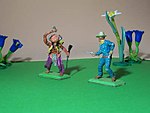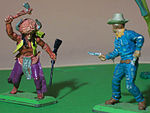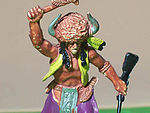Shot (filmmaking)
Infilmmakingandvideo production,ashotis a series offramesthat runs for an uninterrupted period of time.[1]Film shots are an essential aspect of amoviewhereangles,transitionsandcutsare used to further express emotion, ideas and movement. The term "shot" can refer to two different parts of the filmmaking process:
- In production, a shot is the moment that the camera starts rolling until the moment it stops.
- Infilm editing,a shot is the continuous footage or sequence between two edits or cuts.[2]
Etymology
[edit]The term "shot" is derived from the early days of film production when cameras were hand-cranked, and operated similarly to the hand-crankedmachine gunsof the time. That is, a cameraman would "shoot" film the way someone would "shoot" bullets from a machine gun.[3]
Categories of shots
[edit]
Shots can be categorized in a number of ways.[2]
By field size
[edit]The field size explains how much of the subject and its surrounding area is visible within the camera'sfield of view,and is determined by two factors: the distance of the subject from the camera ( "camera-subject distance" ) and thefocal lengthof the lens. Note that the shorter a lens's focal length, the wider itsangle of view(the 'angle' inwide-angle lens,for instance, which is "how much you see" ), so the same idea can also be expressed as that the lens's angle of view plus camera-subject distance is the camera's field of view.
- thelong shotor wide shot (often used as anestablishing shot), that shows the environment around the subjects,
- thefull shot,where the entirety of the subject is just visible within the frame,
- the medium-long shot, where the frame ends near the knees,
- themedium shot,where the frame stops either just above or just below the waist,
- the medium close-up, where more of the shoulder is visible than in the close-up,
- theclose-up,where the shoulder line is visible,
- the extreme close-up, where the frame stops at the subject's chin and forehead.
Three less often used field sizes are:
- theextreme long shot(used for epic views and panoramas),
- theAmerican shot(also 3/4 shot), a slight variation of the medium-long shot to also includeoutside the waistbandhandgun holstersinWestern movies,a characterization from Frenchfilm criticismfor a type of shot in certain American films of the1930sand1940salso referred to as a "Cowboy shot" in reference to the gun holster being just above the bottom frame line,
- the "Italian shot", where only a person's eyes are visible, named after the genre ofItalo-Westerns,particularly theDollars TrilogybySergio Leone,that established this particularfield size.[4]
By camera placement
[edit]"Shots" referring to camera placement and angle rather than field size include:[5]
- Camera angles:
- theaerial shot,
- thebird's-eye shot(sometimes performed as acrane shot),
- thelow-angle shot,
- theover the shoulder shot,
- thepoint of view shot,
- thereverse shotis defined as a 180-degree camera turn to the preceding image, common inpoint of viewandover the shoulder(in the latter, care must be applied to avoid a continuity error by violating the180 degree rule),
- thetwo shotwhere two people are in the picture.
By other criteria
[edit]- theestablishing shotis defined by giving an establishing "broad overview" over a scene, whether performed by a wide shot with a fixed camera, a zoom, a series of different close-ups achieved by camera motion, or a sequence of independent close-angle shots edited right after each other,[2]
- themaster shotis a scene done in one single take, with no editing[citation needed]
- thefreeze frame shotis created in editing by displaying a single frame for an elongated duration of time[citation needed]
- theinsert shotis created in editing by replacing a picture with another while the audio stays the same[citation needed]
- the dolly shot, also known as a tracking or trolley shot, in which the camera moves toward or away from its subject while filming. Traditionally dolly shots are filmed from acamera dollybut the same motion may also be performed with aSteadicamorgimbal.A dolly shot is generally described in terms of "dollying in" or "dollying out".[citation needed]
Film editing
[edit]
Cutting between shots taken at different times or from different perspectives is known asfilm editing,and is one of the central arts of filmmaking.[6]
Duration
[edit]The length of shots is an important consideration that can greatly affect a film. The purpose of editing any given scene is to create a representation of the way the scene might be perceived by the "story teller." Shots with a longer duration can make a scene seem more relaxed and slower-paced whereas shots with a shorter duration can make a scene seem urgent and faster-paced.
The average shot length (ASL) of a film is one of its cinemetrical measures. For example,The Misthas a length of 117 minutes and consists of 1292 shots, so the ASL is 5.4 seconds, whileRussian Arkis a single 96-minutelong take,so an ASL of 96 minutes or about 5,760 seconds, a factor of 1,000 difference.
Shots with extremely long durations are difficult to do because any error in the shot would force the filmmaker to restart from scratch, and are thus only occasionally used. Films famous for theirlong cutsincludeFrancis Ford Coppola'sThe Godfatherin which the entire first scene is a long take featuring Bonasera describing the assault on his daughter, andAlfred Hitchcock'sRope,which only cuts at the end of eachreel,and does so surreptitiously so that it seems as if the whole film is one take.Orson Welles'sTouch of Evilopens with a long tracking crane shot, as doesRobert Altman'sThe Player.
In addition toRussianArk, which was made in 2002 using digital recording technology, other films known for their extremely long takes includeStanley Kubrick's2001: A Space Odysseyand the works ofAndrei Tarkovskystarting withSolaris.Béla Tarris also known for using very long takes consistently in his films. Joss Whedon's feature filmSerenityintroduces the main characters with a long take. AlthoughFish & Catis a single 134-minute long take, the narrator succeeded in playing with time and including severalflashbacks.
See also
[edit]References
[edit]- ^Sklar, Robert.Film: An International History of the Medium.[London]: Thames and Hudson, [c. 1990]. p. 526.
- ^abcAscher, Steven, and Edward Pincus.The Filmmaker's Handbook: A Comprehensive Guide for the Digital Age.New York: Plume, 1999. p. 214.
- ^"Movie Speak; Scissorhands Revisited".Archivedfrom the original on 2018-09-13.Podcast. "KCRW's The Business."KCRW89.9 FM.10 August 2009.
- ^Bowen, Christopher J. (2018).Grammar of the Shot(4th ed.). New York: Routledge. p. 21.ISBN9781351803526.RetrievedAugust 11,2023.
- ^Ascher, 214-218
- ^Ascher, 346







